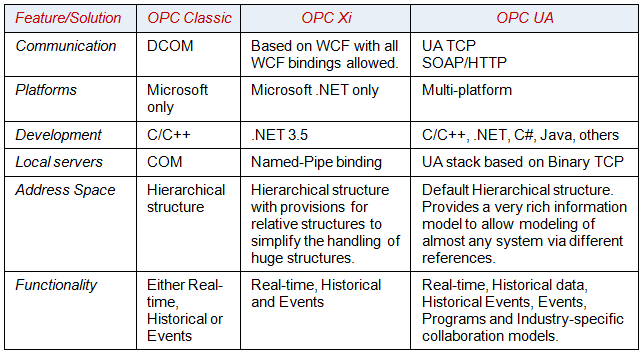
Editor's Ramblings
2009 Significant events : What is OPC in 2010?
by
Manny Mandrusiak (Guest Contributor)
|
January, 2010
The end of the year also leads to all of the “Year in Review” articles, magazines, and television specials. Now I am not always a fan of these specials, but it is often great to review the past year, and look into the crystal ball to see what the future holds.
From an OPC Foundation perspective there have been some extremely significant events which are milestones in the evolution of OPC technology as a communications protocol.
2009 Significant events
- OPC ADI (Analyzer Device Integration) was developed as a companion specification and demonstrated at Achema in May of 2009.
- Collaboration between PLCOpen and the OPC Foundation resulted in a combination of OPC Unified Architecture (OPC UA) and IEC 61131-3 to provide a manufacturing independent information and communication architecture.
- OPC Unified Architecture Developer workshops were conducted in Frankfurt, Germany and New Orleans, Louisiana, USA to continue the adoption of OPC UA.
- OPC Xi was added to the OPC Foundation portfolio.
- OPC Foundation Europe is working to form an active OPC European Steering Committee to facilitate the adoption of OPC technology in Europe.
What is OPC in 2010? OPC provides the infrastructure and foundation to facilitate the vendor neutral transfer of data into information. As with any Open Standard, there are many flavors of OPC such as: OPC DA, OPC HDA, OPC A&E etc. Let’s demystify things:

OPC Classic
The OPC that everyone knows and uses today. Based on a Client/Server technology, OPC Classic contains the OPC COM/DCOM, OPC DA, OPC A&E, OPC HAD, OPC Security specifications. It was designed based on Microsoft’s Active X (OLE), COM and DCOM technology. In a nut shell, OPC Classic defines a common set of interfaces, methods, and properties that enables the transfer of Industrial data between a Server and a Client. An OPC Server provides the information at the request of an OPC Client. Essentially if one wanted to use OPC for communications between devices and controllers in the same domain then OPC Classic works extremely well.
OPC Xi
OPC Xi was produced as the result of collaboration of several OPC Foundation vendor companies to develop an easily integrated and secure OPC solution that provides a .Net migration path from OPC Classic. OPC Xi is perfect for individuals who work solely in a Microsoft environment and need secure communications outside a firewall, and do not want to build a combined product OPC solution.
OPC Xi provides:
- Client server data exchange
- Support for OPC DA, OPC HDA, and OPC A&E
- Provides secure real-time and historical data transfer
- Navigates firewalls
- Secure web services
OPC Unified Architecture is the next generation of OPC evolution. It is based on the functionality of all the OPC Classic Specifications (OPC DA, OPC A&E, Commands, and Complex Data. OPC Unified Architecture is designed to be platform independent, scalable, secure, and provide high performance. Furthermore, the abstract design of the technology allows OPC UA to be used as the underlying implementation for which other protocols/standards can use, such as PLCOpen and BACNet etc. Not only does this capability reduce the efforts of other consortiums, but it also adds more value to your existing OPC UA software that will automatically be compatible with, and able to consume the data from systems using these other standards (built on OPC UA).
OPC UA is the only Open standard that is designed to be usable in all layers of your enterprise, from the embedded device all the way up into your enterprise systems.
Where does OPC fit in the plant of 2010?

There is no doubt that 2010 will continue to be a year of evolution, as networks and network technologies continue to move forward.
I wish everyone a safe and happy holiday season.
Cheers,
Manny Mandrusiak
